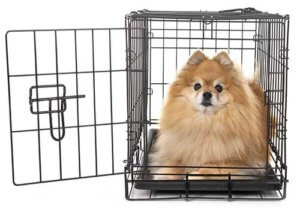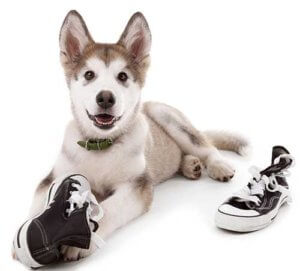A New Puppy
 Crate training is a very safe, comfortable, and effective method of housebreaking your new puppy. The crate simulates a den which dogs instinctively keep clean. Dogs will not urinate of defecate in a small area where they sleep and eat. Puppies actually feel secure and safe in the crate. After a brief initial adjustment period, your puppy will soon accept the crate as its own special place of security and privacy.
Crate training is a very safe, comfortable, and effective method of housebreaking your new puppy. The crate simulates a den which dogs instinctively keep clean. Dogs will not urinate of defecate in a small area where they sleep and eat. Puppies actually feel secure and safe in the crate. After a brief initial adjustment period, your puppy will soon accept the crate as its own special place of security and privacy.
Crate training offers many benefits for you and your new puppy. Puppies would prefer to be prevented from causing trouble than to be punished for it later. The crate offers peace of mind when leaving your puppy or dog home alone. Nothing can be soiled, chewed, or destroyed, and your pet is comfortable, protected, and discouraged from developing bad habits. The crate enables you to housebreak your puppy more quickly by using close confinement to encourage control, establish a regular routine for outdoor elimination, and prevent accidents. The crate can effectively confine your puppy or dog during meals or when he may be underfoot, overexcited, or ill. Some examples of this type of confinement may include family gatherings, guest, workmen, or home construction. The crate can facilitate travel by securing your pet while in the vehicle or while staying at your destination. A familiar, comfortable piece of home offers security.
What size crate should I buy?
 The proper size crate is essential. The pet should have just enough room to stand, turn around, and lie down comfortably. It is best to start with a smaller size crate, then graduate to a larger crate as your puppy grows. A crate that is too large for a young puppy defeats its purpose of providing security and promoting bladder and bowel control. The puppy’s allotted space should be limited while housebreaking.
The proper size crate is essential. The pet should have just enough room to stand, turn around, and lie down comfortably. It is best to start with a smaller size crate, then graduate to a larger crate as your puppy grows. A crate that is too large for a young puppy defeats its purpose of providing security and promoting bladder and bowel control. The puppy’s allotted space should be limited while housebreaking.
Where should I put the crate?
Puppies are naturally pack animals and want to be part of the family, so the location of the crate should be in a “people” area of the house, such as the kitchen or family room. To provide an even greater sense of security and privacy, place the crate in a corner or against a wall and cover the sides and back with a sheet, blanket, or towel. The amount of coverage can be increased to encourage nap time or bed time. Avoid putting newspaper in or under the crate, since it may confuse the puppy and encourage elimination. Do not put water in the crate, because most puppies will simply spill it.
It is very important for children to be taught to respect the puppy’s crate as his private space. Children should learn to leave the puppy alone when he is in the crate, either by his own choosing or due to nap time, feeding, or bed time. Children also should not play in the puppy’s crate. However, you should accustom the puppy from the beginning to accept your reaching into the crate at any time.
When should I use the crate?
While the puppy is housebreaking and passing through mouthing and chewing stages, he should be in the crate whenever you are unable to give him 100% of your attention. Use the crate as you would place a toddler in a play pen or crib. At night, you may choose to move the crate to the bedroom so the puppy sleeps near you, yet he is safely confined.
You may elect to place a safe chew toy such as a “Nylabone” or “Kong” in the crate with your puppy. Remove any bedding material or cushion if the puppy chews it. It is much better for the puppy to lie on a bare surface than to risk ingestion of material and possible subsequent stomach or intestinal obstruction.
Your new puppy can enjoy routine naps during the day in his crate. For short outings, your puppy should be confined safely in his crate. As a rule, a 3-month-old puppy may be left in the crate for 3 to 4 hours; a 4-month-old puppy may be left for 4 to 5 hours and so on. Remember to exercise your puppy before placing him in the crate and immediately upon your arrival. Consider leaving a light on and the radio playing soft or classical music to soothe him while you are away.
The crate is a wonderful training tool, but it must not be abused. The crate is not intended to be used for long hours by absent owners. If you are unable to exercise your puppy regularly, make arrangements with a neighbor, relative, or qualified pet sitter.
Introducing your new puppy to the crate
Most puppies adjust and accept the crate in just a few days. Start by placing the puppy in the crate and allowing him to explore and exit as he wishes. Place him in the crate repeatedly, offering a small treat and without closing the door. You may also toss the treat into the crate, and encourage the puppy to enter and find the treat, cheering him on enthusiastically. Aim to create a positive environment surrounding the crate.
If your puppy happens to have an accident in the crate, it may be too large a space or he may need to also eat in the crate. By feeding your puppy in his crate, you foster the puppy’s den instinct to avoid soiling where he eats and sleeps. Do not offer water in the crate because most puppies tend to spill it or enjoy overdrinking, thus complicating housebreaking efforts.
The importance of a schedule
Feeding your new puppy on a schedule greatly assists successful housebreaking. Feed very young puppies 3 times daily, allowing no more than 30 minutes to eat. Then pick up the food. Whatever is left over will wait until the next meal. Most puppies need to be exercised 5 to 15 minutes after each meal.
Generally, puppies need to be exercised upon rising in the morning, after each meal, after each nap, and before bedtime. Your puppy’s only indication that he needs to eliminate may be a quick sniff along the floor. It’s not much warning, so be vigilant.
Consistency is key in housebreaking. Take the puppy out on a leash to the same location each and every time, and give a command such as “hurry up”, “do it”, “go pee pee”, or whatever else may work for your family. Allow the puppy several minutes outside to sniff. Praise excessively for a job well done. If the puppy is more interested in playing outside, bring him back in. At this stage in his training, outdoors is for elimination only. Later, when housebroken, playtime can include the outdoors.
Getting through the night
 To help ensure that your puppy sleeps soundly through the night, restrict water intake after 7 PM. Exercise him just before your bedtime, and place him in his crate to sleep. Remember to cover the crate to indicate bedtime and create darkness.
To help ensure that your puppy sleeps soundly through the night, restrict water intake after 7 PM. Exercise him just before your bedtime, and place him in his crate to sleep. Remember to cover the crate to indicate bedtime and create darkness.
If he whimpers, screams, barks, digs, etc., firmly tell him “quiet”. Allow him several minutes to settle down. When he is quiet, reinforce him positively with “good night”. Most puppies adjust to sleeping all night in the crate in a short time. Avoid letting the puppy out of the crate just to stop his crying, because this teaches him to cry when he wants to be free.
Accidents will happen
Be patient. Your puppy will have accidents. Punishment serves no purpose, since puppies have a very short memory. The only situation in which you can correct your puppy is when you catch him in the act of urinating or defecating inappropriately. A sharp “No!” followed by whisking him outside is effective. The sudden “No!” startles him and will be directly associated with the accident. Even though the puppy may have finished eliminating in the house, taking him outside reinforces the desired location. Praise the puppy if he continues to eliminate outside.
Clean up the soiled area with an odor-neutralizing cleaner such as “Elimin-odor”, “Nature’s Miracle”, or “Simple Solution”. Removing the odor reduces the puppy’s tendency to mark in that area again.
Never hit your puppy. Striking him or verbally abusing him will only make him hand-shy, nervous, and destroy his willingness to trust people.
Challenges of puppyhood
 Most puppies go through a mouthy, chewing phase. It is normal for puppies to chew. In fact, puppies need to chew to develop their jaws, aid in teeth eruption, and explore their environment. Understanding this need to chew, we need to properly direct this behavior toward acceptable, safe chew toys.
Most puppies go through a mouthy, chewing phase. It is normal for puppies to chew. In fact, puppies need to chew to develop their jaws, aid in teeth eruption, and explore their environment. Understanding this need to chew, we need to properly direct this behavior toward acceptable, safe chew toys.
Provide a variety of safe toys such as “Nylabones”, “Gumabones”, and “Kongs”, which are readily available in pet stores. Do not expect your puppy to differentiate between old socks or shoes and new ones, or between a rag you’re taunting him with and valuable clothing.
Whenever you catch your puppy chewing on anything that is not one of his toys, say “no” and redirect their attention to one of their own toys. Products such as “Bitter Apple”, “Bitter Lyme”, “Bitter End”, and hot pepper formulations can be used to deter your puppy from chewing inappropriate objects, cabinets, and furniture.
Avoid playing tug-of-war with your puppy. This game sets up a direct challenge between you and your puppy and may foster competition and aggression.
Puppies often bite as they play. Although this rough form of play is normal, it is unpleasant. One way to promote healthier play sessions is to include a toy rather than your hands alone. If you feel your puppy’s teeth on your skin, say “no” and stop playing with him. Offer him a toy in substitution. Sometimes, puppies become very rambunctious and mouthy. In these situations, a brief “time out” in the crate is effective. This sends the message that “I won’t play with you unless you play nicely.” After a few minutes of quiet, the puppy is ready to rejoin the family.
Some Final Thoughts
A well-trained dog is a joy to own. Remember to be patient, consistent, and firm. Always praise your puppy for good behavior, for then, it will be repeated.
Canine Preventive Care
Distemper vaccine
 Puppies receive a combination Distemper, Hepatitis ( also called Adenovirus 2), Parainfluenza, and Parvovirus (DHPP) vaccine at each puppy visit. This combination vaccine protects your puppy or dog from serious and incurable neurologic, hepatic (liver), intestinal, renal (kidney) and respiratory viruses. Puppies are vaccinated every 3-4 weeks starting at 6-8 weeks of age and continuing to at least 16 weeks of age. The distemper “combo” vaccine is boostered annually.
Puppies receive a combination Distemper, Hepatitis ( also called Adenovirus 2), Parainfluenza, and Parvovirus (DHPP) vaccine at each puppy visit. This combination vaccine protects your puppy or dog from serious and incurable neurologic, hepatic (liver), intestinal, renal (kidney) and respiratory viruses. Puppies are vaccinated every 3-4 weeks starting at 6-8 weeks of age and continuing to at least 16 weeks of age. The distemper “combo” vaccine is boostered annually.
Rabies
Rabies is a potentially fatal viral illness. Rabies vaccine is given to puppies and kittens 12 weeks of age or older and is effective for 1 year initially and for 3 years following subsequent vaccines. All dogs and cats are required to be licensed annually in the town of residence as proof of rabies vaccination.
Lyme
Lyme vaccine protects against a widespread tick-borne bacterial disease (Borrelia burgdorferi) . Lyme disease most commonly causes lameness but may also affect kidney function. Lyme vaccine may be given to puppies over 12 weeks of age. It is boostered 3-4 weeks later and annually thereafter. In addition to vaccinating, tick control is essential in preventing lyme disease. Effective prevention of fleas and ticks is achieved by applying an FDA-approved topical product monthly.
Leptospirosis
Leptospirosis is a bacterial illness which severely affects the kidneys and liver. Leptospirosis is contagious to people, too. The organism is spread through infected urine deposited by dogs, cats, rodents, and wild animals. It may also be found in contaminated food, water, soil, and vegetation. Vaccination is recommended for all dogs over 6 weeks of age, boostered 2-4 weeks later and repeated annually.
Bordetella or Kennel Cough
Kennel Cough Complex (Bordetella bronchiseptica) is a highly contagious respiratory disease encountered primarily by dogs that are boarded at kennels, frequent grooming salons, attend shows or contact other dogs at places like the parks or pet stores. Puppies may be protected via intranasal, oral or injectable vaccines as early as 6-8 weeks of age. The vaccine is then boostered every 6 months to one year.
Canine Influenza
Canine flu is a highly contagious viral infection among dogs. This disease is most commonly transmitted in shelters, boarding facilities, dog shows and grooming salons. The signs of canine flu often mimic those of kennel cough. Canine flu may present as a mild persistant cough or, more severely, as pneumonia with a high fever. The best prevention is annual vaccination which will reduce the severity of disease if encountered and limit shedding of the virus, thus, protecting other dogs. As of 2013, the New Jersey Department of Health has no evidence that Canine Influenza Virus can be transmitted from dogs to people.
Heartworm Disease
Heartworm disease is a blood parasite transmitted by mosquitoes which obstructs blood vessels near the heart and can cause severe heart disease and even death. Since signs of heartworm disease usually do not appear until late in the course of disease, a blood test must be taken every year to ensure that your dog is heartworm free and can safely continue to receive preventative medication. Monthly oral heartworm preventative can safely be given to puppies who are 6 weeks of age or older. Heartworm preventatives should be given to dogs all year round.
Intestinal Worms
Nearly all puppies and kittens are born with intestinal worms, most commonly roundworms, hookworms, coccidia and giardia. Most puppies and kittens become infected during fetal development. Several types of intestinal parasites may be contracted from the environment via soil, feces, bodies of water and in congested areas such as the parks. Tapeworms are one type of intestinal parasite which are transmitted to your pet by fleas. Routine fecal samples allow us to check your pet for intestinal worms and treat appropriately. Standard hand washing practices and good hygiene will protect you and your family from intestinal parasites.
Fleas and Ticks
Fleas and ticks carry several diseases ( lyme disease, rocky mountain spotted fever, ehrlichiosis, anaplasmosis, hemobartonellosis, tapeworms, tularemia, cytauxzoonosis, babesiosis). Some of these diseases are contagious to people. In recent years, these parasites are present all year round. Just one unseasonably warm Winter day can assist their survival. Once fleas have entered your home, they may remain dormant for 3-6 months prior to reemerging. Fleas and ticks are best controlled by applying a topical product on the pet’s back once monthly throughout the year. The liquid medication may be applied at bed time so that no one reduces its effectiveness by petting the pet. These products migrate over the pet’s body and reside in the hair follicles. Excessive bathing or swimming will reduce the effectiveness of these protective products.
Suggested Canine Diets
- Avoderm
- Blue Buffalo
- Blue Buffalo Wilderness
- Canidae
- Evo
- Innova
- Merrick
- Nutro Ultra
- Organix
- Pet Promise
- Science Diet Nature’s Best
- Solid Gold
- Wellness
More Information on Pet Health
-
Cats need veterinarians
-
Feeding your cat
-
Essential Oils and Your Pet
-
Spaying and Neutering
-
Frequently Asked Questions



